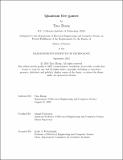Quantum free games
Author(s)
Zhang, Tina
DownloadThesis PDF (1.030Mb)
Advisor
Natarajan, Anand
Terms of use
Metadata
Show full item recordAbstract
The complexity of free games with two or more classical players was essentially settled by Aaronson, Impagliazzo, and Moshkovitz [AIM14]. In the quantum world, there are two complexity classes that can be considered quantum analogues of classical free games: (1) AM⇤, the multiprover interactive proof class corresponding to free games with entangled players, and, somewhat less obviously, (2) BellQMA(2), the class of quantum Merlin-Arthur proof systems with two unentangled Merlins, whose proof states are separately measured by Arthur. In this work, we make significant progress towards a tight characterization of both of these classes.
1. We show a BellQMA(2) protocol for 3SAT on n variables, where the total amount of communication is Õ(√n). This answers an open question of Chen and Drucker [CD10] and also shows, conditional on ETH, that the algorithm of Brandao, Christandl and Yard [BCY10] for optimizing ˜ over separable states is tight up to logarithmic factors.
2. We show that AM*[ⁿprovers = 2, q = O(1), a = poly log(n)] = RE, i.e. that free entangled games with constant-sized questions are as powerful as general entangled games. (In contrast, [AIM14] shows that classical free games are much weaker than general classical games.) We show this using a question “hyper-compression” theorem that iteratively applies the introspection technique of Ji et al. [JNV⁺20]. Our result is a significant improvement over the headline result of Ji et al., whose MIP⇤ protocol for the halting problem has poly(n)-sized questions and answers.
3. By the same techniques, we obtain a zero-gap AM* protocol for a P2 complete language with constant-size questions and almost logarithmically (O(log n · log* n)) large answers, improving on the headline result of Mousavi, Nezhadi and Yuen [MNY21].
4. Using a connection to the nonuniform complexity of the halting problem we show that any MIP* protocol for RE requires W(log n) bits of communication. It follows that our results in item 3 are optimal up to an O(log* n) factor, and that the gapless compression theorems of [MNY21] are asymptotically optimal. We conjecture that these bounds can be saturated in the gapped case as well.
Date issued
2024-09Department
Massachusetts Institute of Technology. Department of Electrical Engineering and Computer SciencePublisher
Massachusetts Institute of Technology